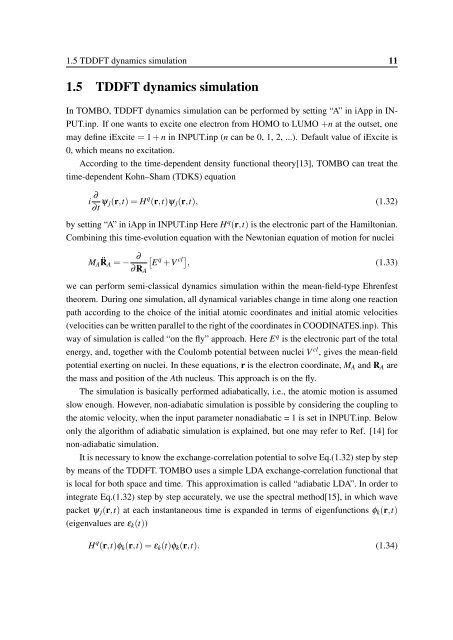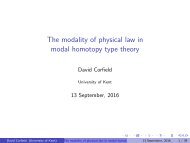TOMBO Ver.2 Manual
TOMBO
TOMBO
You also want an ePaper? Increase the reach of your titles
YUMPU automatically turns print PDFs into web optimized ePapers that Google loves.
1.5 TDDFT dynamics simulation 11<br />
1.5 TDDFT dynamics simulation<br />
In <strong>TOMBO</strong>, TDDFT dynamics simulation can be performed by setting “A” in iApp in IN-<br />
PUT.inp. If one wants to excite one electron from HOMO to LUMO +n at the outset, one<br />
may define iExcite = 1 + n in INPUT.inp (n can be 0, 1, 2, ...). Default value of iExcite is<br />
0, which means no excitation.<br />
According to the time-dependent density functional theory[13], <strong>TOMBO</strong> can treat the<br />
time-dependent Kohn–Sham (TDKS) equation<br />
i ∂ ∂t ψ j(r,t) = H q (r,t)ψ j (r,t), (1.32)<br />
by setting “A” in iApp in INPUT.inp Here H q (r,t) is the electronic part of the Hamiltonian.<br />
Combining this time-evolution equation with the Newtonian equation of motion for nuclei<br />
M A ¨R A = − ∂<br />
∂R A<br />
[<br />
E q +V cl] , (1.33)<br />
we can perform semi-classical dynamics simulation within the mean-field-type Ehrenfest<br />
theorem. During one simulation, all dynamical variables change in time along one reaction<br />
path according to the choice of the initial atomic coordinates and initial atomic velocities<br />
(velocities can be written parallel to the right of the coordinates in COODINATES.inp). This<br />
way of simulation is called “on the fly” approach. Here E q is the electronic part of the total<br />
energy, and, together with the Coulomb potential between nuclei V cl , gives the mean-field<br />
potential exerting on nuclei. In these equations, r is the electron coordinate, M A and R A are<br />
the mass and position of the Ath nucleus. This approach is on the fly.<br />
The simulation is basically performed adiabatically, i.e., the atomic motion is assumed<br />
slow enough. However, non-adiabatic simulation is possible by considering the coupling to<br />
the atomic velocity, when the input parameter nonadiabatic = 1 is set in INPUT.inp. Below<br />
only the algorithm of adiabatic simulation is explained, but one may refer to Ref. [14] for<br />
non-adiabatic simulation.<br />
It is necessary to know the exchange-correlation potential to solve Eq.(1.32) step by step<br />
by means of the TDDFT. <strong>TOMBO</strong> uses a simple LDA exchange-correlation functional that<br />
is local for both space and time. This approximation is called “adiabatic LDA”. In order to<br />
integrate Eq.(1.32) step by step accurately, we use the spectral method[15], in which wave<br />
packet ψ j (r,t) at each instantaneous time is expanded in terms of eigenfunctions ϕ k (r,t)<br />
(eigenvalues are ε k (t))<br />
H q (r,t)ϕ k (r,t) = ε k (t)ϕ k (r,t). (1.34)



